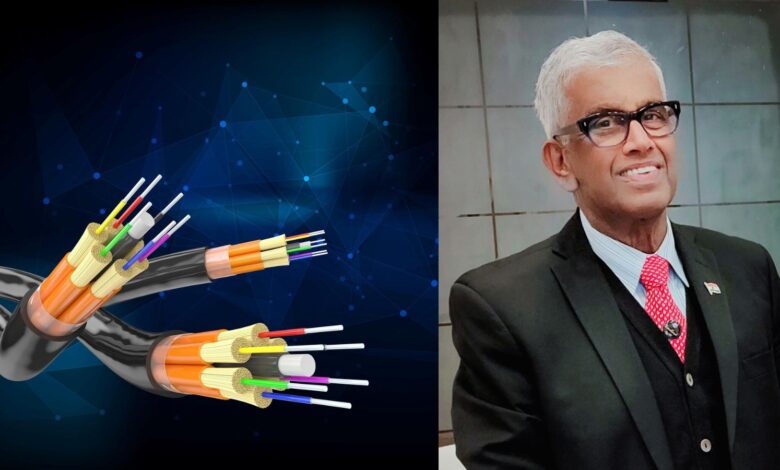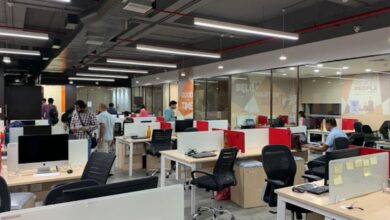‘AI, subsea cables, and data centres are vitally interconnected’: Head of Broadband India Forum | Technology News

Amid the AI boom, India is looking to become home to a number of data centres. However, a critical yet possibly overlooked component of the AI and cloud infrastructure needed to position the country as a global data centre hub is submarine or subsea cables.According to Broadband India Forum (BIF) president TV Ramachandran, large language models (LLMs) capable of processing trillions of data units require robust infrastructure for connectivity between data centres located across continents. And subsea cables are a vital component of that global network.
“AI processing means crunching trillions of data units and that ability can’t just rest at one place. The results of that have to be communicated on land and overseas. The data has to go through data centres, data caches, and then it has to enable intercontinental connectivity through subsea cable systems,” Ramachandran said.
Story continues below this ad
Undersea fibre-optic networks are essential for high-speed data transmission, global connectivity, and supporting India’s burgeoning digital economy. However, the country’s exing subsea cable infrastructure severely lags behind its data consumption needs.
The head of the industry body, which counts big tech companies and internet service providers as its members, spoke to on the sidelines of India’s first-ever subsea cable conference hosted BIF in New Delhi on Tuesday, March 25.
The inaugural session of the conference saw experts push for more undersea cable deployments in India while industry stakeholders demanded incentives and urgent reforms for ease of business.
Urgent need for more cable landing stations
“Our cable landing stations are at a minuscule level. We may, at best, have 17 to 20 cable landing stations. We don’t have the infrastructure capacity to transmit more than 3 per cent of global traffic through subsea cables, so we cannot be complacent,” Ramachandran said.Story continues below this ad
Cable landing stations or CLS sites are where the subsea cables link up with terrestrial networks enabling Wi-Fi and mobile data. As per a 2022 TRAI report, India has about 17 subsea cables terminating at 14 dinct cable landing stations (CLS) in five cities, namely Mumbai, Chennai, Kochi, Thoothukudi, and Thiruvananthapuram. In contrast, smaller countries like Singapore have 26 subsea cables landed across three landing sites.
“India’s share of subsea cable landing stations presently constitutes one per cent of the world’s total. India should rightfully have ten times the number of exing cable landing stations and four or five times more capacity of subsea cables as we go forward,” BIF chairperson Aruna Sundararajan, who was formerly the Union Secretary of Electronics and Information Technology, said onstage at Tuesday’s conference.
Echoing Sundararajan’s remarks, Ramachandran said, “While the subsea cable infrastructure we have is probably adequate for today, we have to increase it.”
He also pointed out that India urgently needs its own repair vessels in the event of subsea cable disruptions. “We are dependent on three service providers who can come and work in Indian territorial waters. But it will take six months for them to get here, so will the country remain disconnected for six months?” he asked.Story continues below this ad
Based on recommendations the Telecom Regulatory Authority of India (TRAI), the Department of Telecommunications (DoT) is reportedly contemplating a framework for repair and maintenance of subsea cables in India. Meanwhile, state-owned Telecommunications Consultants India (TCIL) has reportedly been roped in to look into the feasibility of the project and expenses involved.
Setting up an attractive regulatory environment
Industry stakeholders at the conference called on Indian policymakers and regulators to set up a framework for investment opportunities in the sector.
Amit Gupta, the CEO of network infrastructure company Lightstorm pointed out that the capital expenses for laying subsea cables, around $50,000 per kilometre, is not out of range for startups in India.
The subsea cable market size in India is expected to reach $78.6 million 2030, according to TRAI data.Story continues below this ad
When asked to elaborate on what kind of framework is needed to facilitate investments in the sector, BIF’s Ramachandran said, “This is not a sector which you can give it purely to market forces. Because it’s a critical communication element. It is a strategic national asset. Everybody’s agreed on that.”
“If that is so, then, we can’t just leave it to the bottomline approaches. Obviously there has to be facilitation from the government. Not only facilitation, but oversight,” he added.
In June 2023, TRAI recommended a licensing framework and regulatory mechanism for subsea cables landing in India. Only international long dance (ILD) and internet service provider (ISP)-A telecom licence holders can own and operate cable landing stations (CLS), as per the proposal.
It further proposed to simplify the licensing regime only requiring owners of main CLS to seek permissions, while owners of CLS Point of Presence (CLS-PoPs) would be exempt.Story continues below this ad
The telecom regulator also suggested that international subsea cables should be allowed to carry domestic traffic on dedicated fiber pairs between two Indian cities, as long as the licensee ensures that the domestic traffic is not routed through any other country outside India.
On how India’s data localisation push impacts the development of subsea cable networks, Ramachandran opined that it was a “very tricky” policy matter.
“It’s a tricky policy matter. You have to strike a balance somewhere. No country can remain an island. It will perish. I think, in that sense, what they are saying is to connect to trusted sources. Global connectivity with trusted sources must be permitted,” he continued.
When asked about TRAI’s recommendation about domestic subsea cables, Ramachandran said, “Cable landing stations have to be on a coastline, but you can extend it to internal high data consumption points. Whether they are data centres or not, why should state capitals not all be connected?”






